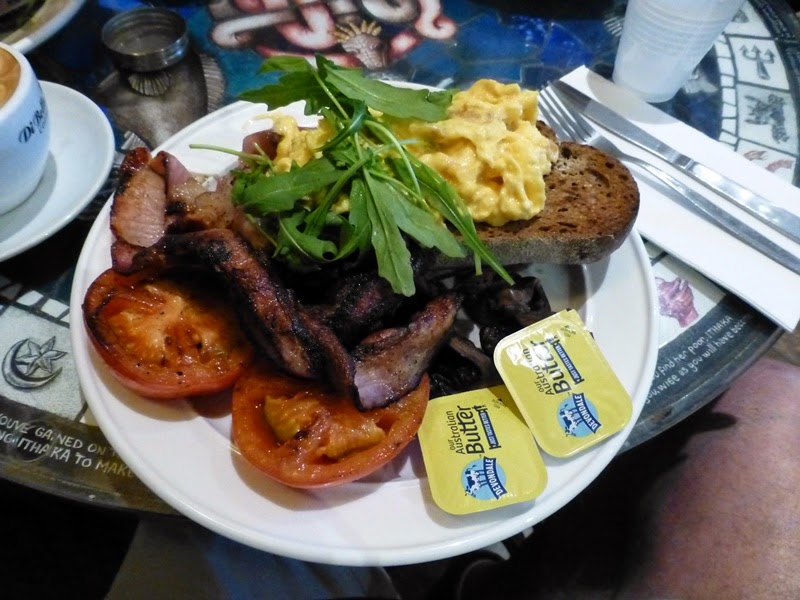Saturday, February 21, 2015
We started the day with a visit to the Perth mint, where to
this day gold prospectors bring gold to be weighted and sold to the
government. In this wheelbarrow are
reproductions of some of the largest nuggets found:
Of the 20 largest gold nuggets ever found, 19 of them were
found in Australia! To this day large
nuggets are sometimes found in the gold fields.
Unfortunately, no photos were allowed in the mint, but we saw the
largest gold coin ever minted, a 1000 kg. coin with a kangaroo on one side and
an image of Queen Elizabeth II on the other.
It was quite a sight. We also saw
the making of a gold bar. The raw gold
was heated to melting in a crucible and poured into a mold, from which, after a
few minutes, it was removed, already hardened, and cooled to room temperature
in a water bath. It was an impressive
process.
From the mint we went to the Western Australia Museum where
we had a guided tour of the Aboriginal section with an anthropologist. She gave us a great introduction to the
Aborigines of Western Australia and of the very spiritual world in which they
live. The word “Dreaming” is the best
translation into English of the complex ideas which include much ancestor
reverence and references, a code of behavior, a belief of a very profound
integration of the land, the water, ancestors and dreaming into a way of
being. An attempt to explain all of this
was in a sign in the museum:
The Law comes from the Dreaming.
The Law is a set of rules for
behaviour.
Elders maintain the Law and ensure
that it is passed on. People say “It’s
the Law” to explain the rules they follow.
Lore also comes from the
Dreaming. It is the stories that contain
the Law.
There was a man with us from one of the aboriginal
communities who also explained some of the differences between those
communities. These differences included
language dialects and alternate ways of carving shields, spears, digging sticks
and other everyday things. It didn’t
seem as if the differences were as great as those we had among the Native
American tribes in North America, but the stories of the abuses of the native
population by the Europeans are horrible and equally as bad as ours.
Here’s a shelter typical of those built by the native people
out where the wind is ferocious. The
closed end of the shelter is into the wind, and the shape of the shelter
creates a wind break for a fire to be built in front of the open part. The wind carries the smoke away, and yet the
heat of the fire warms the inside of the shelter:
There is so much more to learn, and we’ll continue to have
instruction on the aborigines as we get into the southern part of the Northern
Territory.
After lunch we were on our own for the afternoon. Joyce had found a notice that there was an
exhibit at the nearby art gallery of artifacts from the Jewish Ghetto of
Venice. The introduction to the exhibit
explained that in September of 1943, as the Nazi armies invaded Italy, two
elderly men who had been responsible for the religious service of the Spanish
and Levantine Synagogues in the Venetian Ghetto, concealed a selection of
liturgical objects. The men who hid them
died in the concentration camps, and the objects were forgotten until the
recent restoration of the Scola Spagnola—the Spanish Synagogue. We were excited to see this exhibit as we
will be traveling to Rome, Florence and Venice with the Melton program out of
Hebrew University in Jerusalem in October.
The items were spectacular. Here
is a pair of Torah crowns:
And here a selection of rimmonim (Torah-top finials):
The exhibit moves from here to Paris and then back to Venice
some time in 2015, but the exact dates were not given and it’s not clear if
these items will be in Venice when we’re there.
Finally we went back to the hotel, washed up, and went out
into a combination of Saturday night, Chinese New Year, and Fringe
Festival. The city is hopping. Loud, boisterous but good-natured crowds,
music, alcohol, people dressed in an amazing variety of looks, with the young
women, especially, in very revealing and provocative outfits along with shoes
impossible to walk in. We had dinner at
an Outback themed steak place—delicious---and sat at a table on the sidewalk
enjoying the parade in front of us.
Tomorrow, Sunday, we board the Indian-Pacific train and will
spend two nights on it, arriving in Adelaide on Tuesday. No internet on the train, so more in a couple
of days.


















































